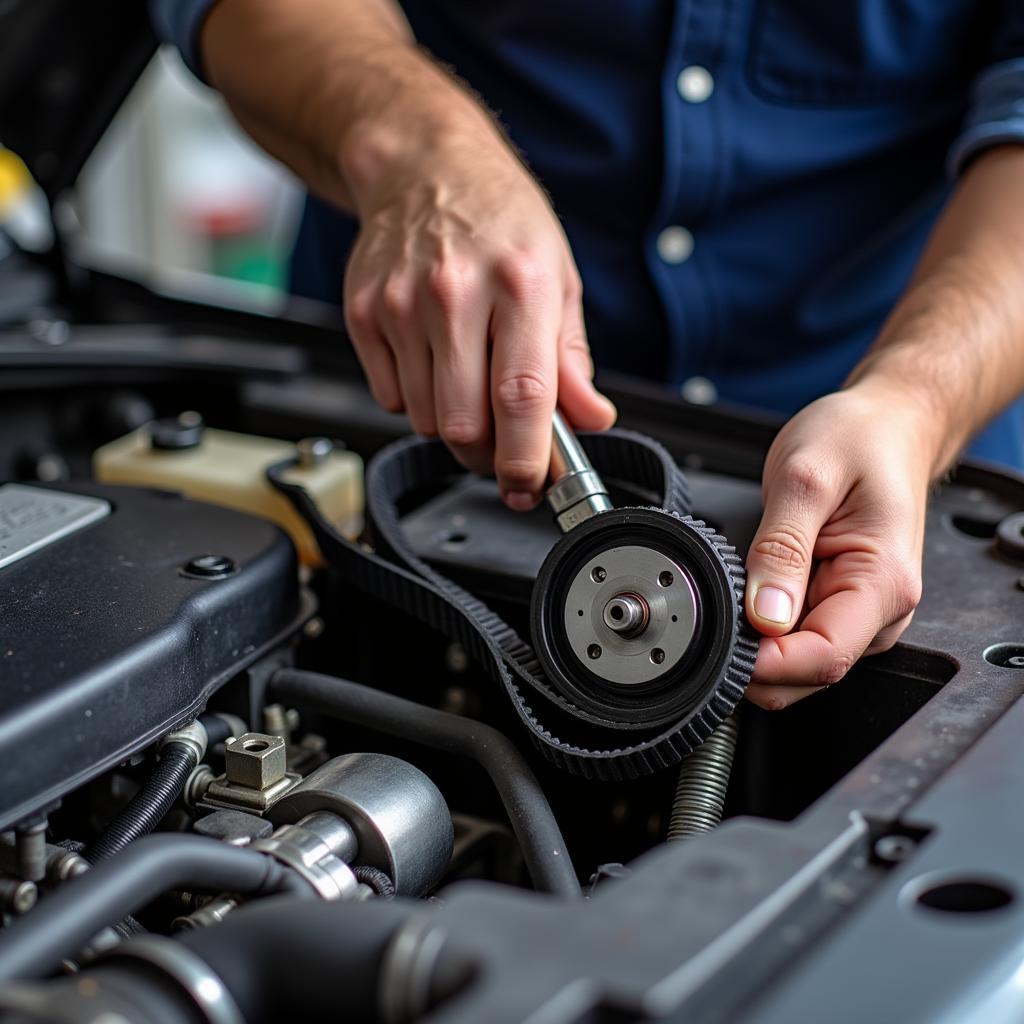Car Not Been Serviced for 3 Years Timing Belt: What You Need to Know
A car not been serviced for 3 years, especially concerning the timing belt, can lead to serious engine problems. Understanding the risks and taking appropriate action is crucial to avoid costly repairs. Let’s dive into the potential issues and what you can do.
 Damaged Timing Belt After 3 Years Without Service
Damaged Timing Belt After 3 Years Without Service
The Importance of Regular Car Servicing
Regular car servicing, including timing belt replacement, is essential for maintaining your vehicle’s performance, reliability, and safety. A well-maintained car performs more efficiently, consumes less fuel, and is less likely to break down unexpectedly. You can find more information regarding service on a car.
Why is the Timing Belt So Critical?
The timing belt synchronizes the rotation of the crankshaft and camshaft, ensuring that the engine’s valves open and close at the correct times. A broken timing belt can lead to significant engine damage, potentially requiring a complete engine rebuild or replacement.
-
Interference Engines: In interference engines, the pistons and valves occupy the same space within the cylinder. A broken timing belt can cause the pistons to collide with the valves, resulting in bent valves, damaged pistons, and potentially a cracked cylinder head.
-
Non-Interference Engines: Non-interference engines have enough clearance between the pistons and valves to prevent collision in case of a timing belt failure. However, a broken timing belt will still leave you stranded and require towing and repair.
What if you have complete service records? Learn more about the benefits of car complete service records.
 Car Engine Damage From Broken Timing Belt
Car Engine Damage From Broken Timing Belt
What Happens if a Car Isn’t Serviced for 3 Years?
Neglecting car service for three years, especially without addressing the timing belt, significantly increases the risk of major mechanical issues. Besides the timing belt, other components can deteriorate, leading to problems such as:
-
Reduced engine performance: Old oil, dirty filters, and worn spark plugs can reduce engine power and fuel efficiency.
-
Brake failure: Brake pads and rotors wear down over time, increasing stopping distances and potentially causing brake failure.
-
Suspension problems: Worn shocks and struts can compromise handling and ride comfort, making the vehicle less safe to drive.
-
Cooling system failure: A neglected cooling system can overheat the engine, causing severe damage.
-
Electrical problems: Corrosion and wear can affect the battery, alternator, and other electrical components, leading to starting issues or complete electrical failure.
Can I Check a Car’s Service History?
Absolutely! Checking a car’s service history provides valuable insights into its maintenance and can help you avoid buying a vehicle with potential problems. Check out resources on can i check a car’s service history.
What to Do if Your Car Hasn’t Been Serviced in 3 Years
If your car hasn’t been serviced in three years, take it to a qualified mechanic immediately. The mechanic should perform a thorough inspection, including a timing belt check.
“A car not serviced for three years is a ticking time bomb,” says John Davis, a certified master technician with over 20 years of experience. “The timing belt is a critical component that should be replaced according to the manufacturer’s recommendations. Ignoring it can lead to catastrophic engine failure.”
 Mechanic Inspecting Timing Belt
Mechanic Inspecting Timing Belt
What Does a Timing Belt Replacement Entail?
Replacing the timing belt involves removing various engine components to access the belt. In addition to the belt, other related parts, such as tensioners and water pumps, might also need replacement.
“Don’t underestimate the importance of a full service history,” adds Sarah Miller, an automotive expert and consultant. “It not only reflects responsible ownership but can also significantly impact resale value.” Learn more about how can lack of service history devalue car. Also, if your car is nearing the 100,000-mile mark, check out information on car 100 000 mile service.
Conclusion
If your car not been serviced for 3 years, addressing the timing belt is paramount. Don’t delay this crucial maintenance task. Regular servicing, including timely timing belt replacement, can save you from costly repairs and ensure your vehicle’s longevity and reliability.
FAQs
- How often should I replace my timing belt? Consult your owner’s manual for the recommended interval. It typically ranges between 60,000 and 100,000 miles.
- What are the signs of a failing timing belt? Unusual engine noises, difficulty starting, and poor engine performance can indicate a problem.
- Can I drive my car with a bad timing belt? No, do not drive your car if you suspect a timing belt issue. Have it towed to a mechanic.
- How much does a timing belt replacement cost? The cost varies depending on the vehicle’s make and model.
- Is it worth replacing the timing belt on an older car? It depends on the car’s overall condition and value. Consult a mechanic for advice.
- Can a worn timing belt affect fuel economy? Yes, a slipping or worn timing belt can disrupt engine timing, leading to reduced fuel efficiency.
- How long does a timing belt replacement take? Typically, it takes a few hours.
Need help with your car’s timing belt or other service needs? Contact us via WhatsApp: +1(641)206-8880, Email: [email protected] or visit us at 456 Oak Avenue, Miami, FL 33101, USA. Our customer service team is available 24/7.

